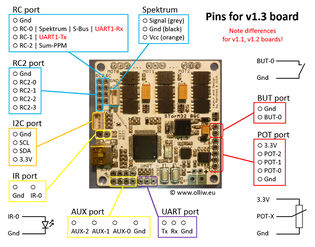Pins and Connectors
The info on this page refers to the v1.3 STorM32-BGC board. For v1.1 and v1.2 boards small but important differences exist; read carefully the comments below. The pins of the v1.31 board are identical to that of the v1.3 board.
This page gives a brief overview and description of the many connections on the STorM32-BGC. For the details of their function and usage refer please to the other wiki pages. Note that some of the hardware functions described here may not yet be supported by the firmware.
The STorM32-BGC connections are grouped into what shall be called ports. A port consists typically of one or more pins, a Gnd pin and possibly a 3.3V pin. The pins of a port are typically labelled by the port name plus a number (e.g. AUX-0 refers to the pin 0 on the AUX port) or, if relevant, by its commonly known function (such as Gnd, 3.3V, Tx, Rx, SCL, SDA etc.). Some pins serve multiple purposes (e.g. pin RC-0 serves as Futaba S-BUS input or UART1-Rx).
Except of the ports POT and BUT all ports are 5 V tolerant, which means that you can apply signals with voltages of up to 5 V to their pins without damaging the board. The ports POT and BUT are however not 5 V tolerant. The voltage on the POT and BUT pins must not exceed 3.3 V.
The 3.3V pins should only be used as supply. Never apply any voltage to a 3.3 V pin (unless you're an expert and know what you do).

The following ports are available:
MOT0, MOT1, MOT2
Function: These ports are the [connectors] for the motors. The yaw motor has to be connected to MOT2.
I2C
Pins: Gnd, SCL, SDA, 3.3V
Function: Connector for the camera MPU module.
I2C#2
Pins: Gnd, SCL, SDA, 3.3V
Function: Connector for an external 2nd MPU module, if this is to be used instead of the on-board MPU.
WARNING: On v1.1 boards the pins of connector I2C#2 are in reverse order to those of connector I2C, which implies also reversed voltage polarity. Pay attention to that before connecting a second IMU to the I2C#2 port.
RC
Pins: Gnd, RC-0, RC-1, RC-2
Function: The pins on this port can serve multiple functions, depending on parameter settings.
Their default function is to provide inputs for RC PWM signals. Typically RC receivers are connected to here. The input pulse lengths of 1 ms to 2 ms are converted to the value range -500 ... 500. The frequency of the input pulses can vary, and can be as high as 430 Hz.
Pin RC-0 can alternatively be configured as input to read the signal line from a Spektrum satellite, or the Futaba S-bus.
Pin RC-2 can alternatively be configured as input for sum PPM signals.
Comment: On v1.1 boards the Futaba S-bus support is not available.
RC2
Pins: Gnd, RC2-0, RC2-1, RC2-2, RC2-3
Function: Inputs for RC PWM signals. Typically RC receivers are connected to here. The input pulse lengths of 1 ms to 2 ms are converted to the value range -500 ... 500. The frequency of the input pulses can vary, and can be as high as 430 Hz.
POT
Pins: Gnd, POT-0, POT-1, POT-2, 3.3V
Function: These three pins are connected to the analog digital converter (ADC) of the microprocessor and hence can digest analog signals. The analog signal is converted to the value range -500...500. Typically the central pins of potentiometers of e.g. a joystick are connected to here; the hot and cold potentiometer pins go then to the Gnd and 3.3V pins.
WARNING: Never apply signals with voltages larger than 3.3 V to any of these pins, this will destroy your board immediately!
BUT
Pins: Gnd, BUT-0
Function: This pin is actually also connected to the analog digital converter (ADC) of the microprocessor, but the analog signal are processed differently than those on the POT port. Currently this port is used to connect a key or switch to it.
WARNING: Never apply signals with voltages larger than 3.3 V to any of these pins, this will destroy your board immediately!
AUX
Pins: Gnd, AUX-0, AUX-1, AUX-2
Function: These are general purpose pins. Currently they are used to connect up to three keys and/or switches.
Comment: On v1.1 and v1.2 boards this port exhibits a 3.3 V pin instead of AUX-2, i.e. the pins are Gnd, AUX-0, AUX-1, 3.3V from right to left.
SPK
Pins: 3.3 V, Gnd, Signal
Function: Connector for a Spektrum satellite receiver.
Comment: On v1.1 boards the connector itself is not available, but the function can be accessed by connecting the Spektrum's signal line to the RC-0 pin.
IR
Pins: Gnd, IR-0
Function: Allows to connect an IR led to remote control a camera.
UART
Pins: Gnd, Rx, Tx
Function: Standard serial port to communicate with the board. The serial is set to 115200 bps, no parity bit, one stop bit. Details of the communication protocol can be found in the Technical Manual.
SWD
Pins: SWDIO, Gnd, SWCLK, 3.3V
Function: Connector for programming the microcontroller using a ST-Link/V2 programming tool.
Comment: On v1.1 boards the labeling of the pins is incorrect. On some boards the issue has been resolved by a sticker.